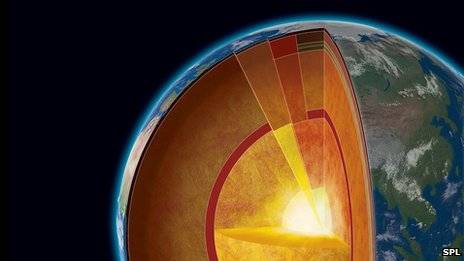JimBowie1958
Old Fogey
- Sep 25, 2011
- 63,590
- 16,753
- 2,220
http://www.nytimes.com/2012/05/29/science/earths-core-the-enigma-1800-miles-below-us.html?_r=4
Cool stuff.
The more we learn the more we realize how much more there is remaining to be learned.
Geologists have long known that Earth’s core, some 1,800 miles beneath our feet, is a dense, chemically doped ball of iron roughly the size of Mars and every bit as alien. It’s a place where pressures bear down with the weight of 3.5 million atmospheres, like 3.5 million skies falling at once on your head, and where temperatures reach 10,000 degrees Fahrenheit — as hot as the surface of the Sun. It’s a place where the term “ironclad agreement” has no meaning, since iron can’t even agree with itself on what form to take. It’s a fluid, it’s a solid, it’s twisting and spiraling like liquid confetti.
Researchers have also known that Earth’s inner Martian makes its outer portions look and feel like home. The core’s heat helps animate the giant jigsaw puzzle of tectonic plates floating far above it, to build up mountains and gouge out seabeds. At the same time, the jostling of core iron generates Earth’ magnetic field, which blocks dangerous cosmic radiation, guides terrestrial wanderers and brightens northern skies with scarves of auroral lights.
Now it turns out that existing models of the core, for all their drama, may not be dramatic enough. Reporting recently in the journal Nature, Dario Alfè of University College London and his colleagues presented evidence that iron in the outer layers of the core is frittering away heat through the wasteful process called conduction at two to three times the rate of previous estimates.
The theoretical consequences of this discrepancy are far-reaching. The scientists say something else must be going on in Earth’s depths to account for the missing thermal energy in their calculations. They and others offer these possibilities:
¶ The core holds a much bigger stash of radioactive material than anyone had suspected, and its decay is giving off heat.
¶ The iron of the innermost core is solidifying at a startlingly fast clip and releasing the latent heat of crystallization in the process.
¶ The chemical interactions among the iron alloys of the core and the rocky silicates of the overlying mantle are much fiercer and more energetic than previously believed.
¶ Or something novel and bizarre is going on, as yet undetermined.
Cool stuff.
The more we learn the more we realize how much more there is remaining to be learned.



